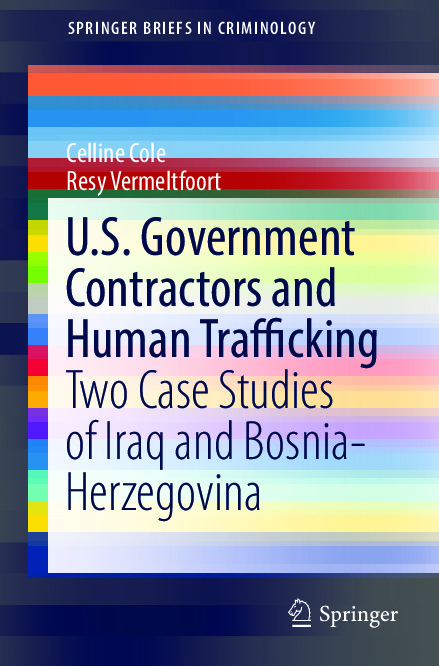File #2503: "2018_Book_USGovernmentContractorsAndHuma.pdf"
Text
1|Dedication|5
1|Foreword|6
1|Acknowledgments|9
1|Contents|10
1|About the Authors|13
1|Abbreviations|14
1|Part I: From Workers to Victims: Human Trafficking and Forced Labor of Third Country Nationals by U.S. Government Contractor KBR, Inc. in Iraq|15
2|Chapter 1: Introduction|16
3|1.1 Structure|18
3|1.2 Method|18
3|1.3 Definitional Clarifications|19
2|Chapter 2: The Private Military Industry|21
3|2.1 Toward the Privatization of Military Tasks|21
3|2.2 Business Branches in the Private Military Industry|22
3|2.3 Implications of the Increased Privatization of Military Tasks|23
3|2.4 The Role of PMCs in Iraq|25
4|2.4.1 Facts and Figures|25
4|2.4.2 KBR in Iraq|26
4|2.4.3 Lessons Learned|27
2|Chapter 3: Human Trafficking and Forced Labor of TCNs in Iraq|29
3|3.1 The Crimes of Human Trafficking and Forced Labor|29
4|3.1.1 Definitions|29
5|3.1.1.1 Human Trafficking|30
5|3.1.1.2 Forced Labor|31
4|3.1.2 Human Trafficking and Forced Labor as International Crimes|32
3|3.2 The Situation of TCNs in Iraq|33
4|3.2.1 Who Are TCNs?|33
4|3.2.2 The Recruitment of TCNs|33
4|3.2.3 TCNs’ Journey to Iraq|35
4|3.2.4 Living and Working Conditions|36
4|3.2.5 Conclusion|37
3|3.3 Documented Cases of TCN Trafficking and Forced Labor|37
4|3.3.1 Daoud and Partners|38
4|3.3.2 Najlaa International Catering Services|38
4|3.3.3 Kulak Construction Company|39
3|3.4 Conclusion|40
2|Chapter 4: Legal Framework|41
3|4.1 The Coalition Provisional Authority Order 17|42
3|4.2 The Uniform Code of Military Justice (UCMJ)|42
3|4.3 The Alien Tort Claims Act (ATCA)|43
3|4.4 The Trafficking Victims Protection Act (TVPA)|44
3|4.5 The Military Extraterritorial Jurisdiction Act (MEJA)|44
3|4.6 Recent Efforts by the USG to Fight Human Trafficking and Forced Labor|45
3|4.7 Conclusion|46
2|Chapter 5: Theoretical Framework|48
3|5.1 State-Corporate Crime|49
3|5.2 The Integrative Model of State-Corporate Crime|50
2|Chapter 6: Analysis|52
3|6.1 Motivations|53
4|6.1.1 Motivations for Contracts|53
4|6.1.2 Motivations for Crimes|54
3|6.2 Opportunities|55
4|6.2.1 Opportunities for Contracts|56
4|6.2.2 Opportunities for Crimes|57
3|6.3 Control|57
4|6.3.1 Control on Prime Contractors|57
4|6.3.2 Control on Subcontractors|58
2|Chapter 7: Summary and Conclusions|61
2|Chapter 8: Discussion|64
1|Part II: From Peacekeepers to Perpetrators: Case Study of Private Contractor DynCorp and Their Complicity in Sex Trafficking in Post-War Bosnia|67
2|Chapter 9: Introduction|68
3|9.1 The DynCorp Case|68
3|9.2 Research Question|70
3|9.3 Methodology|71
3|9.4 Structure|73
2|Chapter 10: Private Military and Security Companies|74
3|10.1 Developments Toward the Privatization of Military and Security Tasks|74
3|10.2 The Market for Force|75
3|10.3 Challenges of Private Military Companies|76
2|Chapter 11: Sex Trafficking and Endeavoring a Cover-Up as International Crimes|78
3|11.1 Sex Trafficking as an International Crime|78
3|11.2 Endeavoring a Cover-Up as an International Crime|80
3|11.3 Rotten Apples or a Rotten Barrel|81
2|Chapter 12: Theoretical Framework|83
3|12.1 State-Corporate Crime|83
3|12.2 The Integrated Model of Kauzlarich and Kramer|84
2|Chapter 13: Analysis and Explanations|89
3|13.1 Motivations|90
3|13.2 Opportunity Structure|92
3|13.3 Operationality of Control|95
3|13.4 Summary|100
2|Chapter 14: Revised Analytical Framework|101
3|14.1 Shortcomings of State-Corporate Crime Theory|101
3|14.2 The Power of Subunit Analysis and a Bidirectional Approach|103
3|14.3 Summary|109
2|Chapter 15: Discussion and Recommendations|111
1|References|114
2|Interviews|118
2|Internet|118
1|Index|121
1|Foreword|6
1|Acknowledgments|9
1|Contents|10
1|About the Authors|13
1|Abbreviations|14
1|Part I: From Workers to Victims: Human Trafficking and Forced Labor of Third Country Nationals by U.S. Government Contractor KBR, Inc. in Iraq|15
2|Chapter 1: Introduction|16
3|1.1 Structure|18
3|1.2 Method|18
3|1.3 Definitional Clarifications|19
2|Chapter 2: The Private Military Industry|21
3|2.1 Toward the Privatization of Military Tasks|21
3|2.2 Business Branches in the Private Military Industry|22
3|2.3 Implications of the Increased Privatization of Military Tasks|23
3|2.4 The Role of PMCs in Iraq|25
4|2.4.1 Facts and Figures|25
4|2.4.2 KBR in Iraq|26
4|2.4.3 Lessons Learned|27
2|Chapter 3: Human Trafficking and Forced Labor of TCNs in Iraq|29
3|3.1 The Crimes of Human Trafficking and Forced Labor|29
4|3.1.1 Definitions|29
5|3.1.1.1 Human Trafficking|30
5|3.1.1.2 Forced Labor|31
4|3.1.2 Human Trafficking and Forced Labor as International Crimes|32
3|3.2 The Situation of TCNs in Iraq|33
4|3.2.1 Who Are TCNs?|33
4|3.2.2 The Recruitment of TCNs|33
4|3.2.3 TCNs’ Journey to Iraq|35
4|3.2.4 Living and Working Conditions|36
4|3.2.5 Conclusion|37
3|3.3 Documented Cases of TCN Trafficking and Forced Labor|37
4|3.3.1 Daoud and Partners|38
4|3.3.2 Najlaa International Catering Services|38
4|3.3.3 Kulak Construction Company|39
3|3.4 Conclusion|40
2|Chapter 4: Legal Framework|41
3|4.1 The Coalition Provisional Authority Order 17|42
3|4.2 The Uniform Code of Military Justice (UCMJ)|42
3|4.3 The Alien Tort Claims Act (ATCA)|43
3|4.4 The Trafficking Victims Protection Act (TVPA)|44
3|4.5 The Military Extraterritorial Jurisdiction Act (MEJA)|44
3|4.6 Recent Efforts by the USG to Fight Human Trafficking and Forced Labor|45
3|4.7 Conclusion|46
2|Chapter 5: Theoretical Framework|48
3|5.1 State-Corporate Crime|49
3|5.2 The Integrative Model of State-Corporate Crime|50
2|Chapter 6: Analysis|52
3|6.1 Motivations|53
4|6.1.1 Motivations for Contracts|53
4|6.1.2 Motivations for Crimes|54
3|6.2 Opportunities|55
4|6.2.1 Opportunities for Contracts|56
4|6.2.2 Opportunities for Crimes|57
3|6.3 Control|57
4|6.3.1 Control on Prime Contractors|57
4|6.3.2 Control on Subcontractors|58
2|Chapter 7: Summary and Conclusions|61
2|Chapter 8: Discussion|64
1|Part II: From Peacekeepers to Perpetrators: Case Study of Private Contractor DynCorp and Their Complicity in Sex Trafficking in Post-War Bosnia|67
2|Chapter 9: Introduction|68
3|9.1 The DynCorp Case|68
3|9.2 Research Question|70
3|9.3 Methodology|71
3|9.4 Structure|73
2|Chapter 10: Private Military and Security Companies|74
3|10.1 Developments Toward the Privatization of Military and Security Tasks|74
3|10.2 The Market for Force|75
3|10.3 Challenges of Private Military Companies|76
2|Chapter 11: Sex Trafficking and Endeavoring a Cover-Up as International Crimes|78
3|11.1 Sex Trafficking as an International Crime|78
3|11.2 Endeavoring a Cover-Up as an International Crime|80
3|11.3 Rotten Apples or a Rotten Barrel|81
2|Chapter 12: Theoretical Framework|83
3|12.1 State-Corporate Crime|83
3|12.2 The Integrated Model of Kauzlarich and Kramer|84
2|Chapter 13: Analysis and Explanations|89
3|13.1 Motivations|90
3|13.2 Opportunity Structure|92
3|13.3 Operationality of Control|95
3|13.4 Summary|100
2|Chapter 14: Revised Analytical Framework|101
3|14.1 Shortcomings of State-Corporate Crime Theory|101
3|14.2 The Power of Subunit Analysis and a Bidirectional Approach|103
3|14.3 Summary|109
2|Chapter 15: Discussion and Recommendations|111
1|References|114
2|Interviews|118
2|Internet|118
1|Index|121

